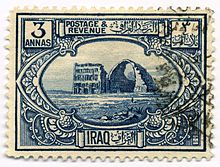
A 1923 3 annas stamp of Iraq showing the ruins at Ctesiphon.
Contents[ |
[edit] Early postal arrangements
The earliest postal service known in the area of present-day Iraq was operated by Assyria; archeologists have found a large number of commercial letters written in cuneiform on clay tablets, and enclosed in addressed clay envelopes.[edit] Ottoman postal service
The Ottoman Empire had post offices at Baghdad, Basra, Mosul, and Kirkuk around 1863. India operated post offices in Baghdad and Basra from 1868 to 1914. During World War I, British and Indian troops fought their way from Basra to Mosul; they used stamps of India overprinted "I.E.F." on their military mail.The British overprinted a variety of Turkish stamps during the occupation, a grouping now conventionally called the issues of "Mesopotamia"; for details, see postage stamps and postal history of Mesopotamia.
[edit] British mandate
The postal service of Iraq proper began with the British mandate granted by the League of Nations in 1920.The first stamps of Iraq were a definitive series that appeared in 1923; the set of 12 included eight different designs depicting scenes and images from ancient history and the present day. They were denominated in annas and rupees, inscribed with "IRAQ" and "POSTAGE & REVENUE". The first stamp depicting Faisal I of Iraq was a 1-rupee value in 1927, followed in 1931 by a series of 13 values.
[edit] Independence
Independence in 1932 brought a new currency (fils and dinar), and the existing Faisal stamps were surcharged accordingly, and issued on 1 April 1932.[1] These were followed soon after (9 May) by stamps of the previous design denominated in the new currency. The accession of King Ghazi necessitated new stamps, which appeared in 1934; they were of the same design as the Faisal stamps, but with a profile of Ghazi in the vignette.Due to Ghazi's unexpected death and the infancy of his son, in 1941 a new series was issued featuring local scenery. Along with additional values and color changes issued the next year, the series totals 23 stamps. 1942 also saw the first stamps depicting Faisal II, who was still a young boy. He appears as a teenager in the next series, which was issued in 1948.
[edit] First commemorative stamps
Iraq's first commemorative stamps came out in 1949 to mark the 75th anniversary of the Universal Postal Union. Faisal's 1953 coronation was also marked by a set of three, along with a souvenir sheet. The last of the Faisal definitives had only partly appeared before the revolution of 1958, and both issued and unissued types were overprinted.General Qassim's period was noted by the usual round of commemoratives, many featuring him as benevolent leader. Later presidents also appeared, though less frequently. Saddam Hussein, as vice-president, makes a first appearance in a souvenir sheet of 1976, and by the mid-1980s appeared on a great many Iraqi stamps.


